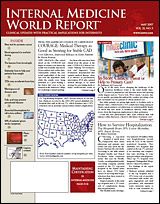Publication
Article
Internal Medicine World Report
New Patient-to-Patient Transmissions: HBV and HIV "Superbug"
Author(s):
Consider Adult Vaccination against Hepatitis B
The first report of patient-to-patient transmission of hepatitis B virus (HBV) and a new super-virulent form of human immunodeficiency virus (HIV) have sparked renewed concerns about novel, or potentially more virulent, viral strains and about the possibility of acquiring infection in a healthcare environment, even with the proper precautions exercised in all health-related workplaces today.
HBV Transmission
J Infect Dis
The first case (. 2007; 195:1311-1314) involves transmission of HBV infection to a 60-year-old woman (the index patient) who was diagnosed with acute HBV infection in April 2002. Her physicians were baffled by the lack of any of the known risk factors—occupational blood exposures, IV drug use, blood or blood product transfusions, household contact with an HBV-infected person, or a history of hemodialysis. In addition, the patient had been celibate for years.
In October 2001, she had 7 teeth extracted. An investigation discovered that a 36-year-old woman with chronic HBV and a high viral load had oral surgery in the same operative suite 161 minutes before the index patient. DNA sequencing revealed that the virus was identical in both women.
IMWR
“We don’t really know how the virus was transmitted in this setting,” Ban Michu Allos, MD, coauthor of the accompanying editorial (pages 1245-1247), told . “It’s possible that the dentist didn’t use precautions. But it…looked like they were doing what they were supposed to be doing.” The investigators reviewed the sterilization of all instruments and adherence to all hygiene procedures in that office.
“I think awareness in the medical community is still pretty strong, because of hepatitis C, for which there is no vaccine and no prevention strategy other than universal precautions,” said Dr Allos, from the Division of Infectious Disease, Department of Medicine, and Department of Preventive Medicine at the Vanderbilt University School of Medicine in Nashville, Tenn. However, “nobody’s perfect, and probably following the precautions doesn’t occur as rigorously as we would like.”
The tenacity of the virus responsible for hepatitis B has been suggested as the key, since HBV can remain active in blood on inert surfaces for a week or more, even in blood invisible to the naked eye.
This begs the question—Is this case an aberration or much more common than we think? “I don’t know how often this occurs. It may be very rare; it may be more frequent than anybody thinks. It’s the sort of thing that would be very difficult to see if you weren’t searching for it,” Dr Allos said.
In addition to following all infection control precautions and reassuring concerned patients, primary care physicians should advise concerned patients to “get vaccinated against hepatitis B,” she says.
Dr Allos advocates routine hepatitis B vaccination for all adults up to the age of 40. “Currently it’s recommended for everybody up to the age of 18, but that misses a lot of people.”
In this particular case, none of the 25 additional patients who underwent dental surgery after the source patient was infected with the same virus; review of their medical records revealed that 66% of them had received all 3 hepatitis B vaccine doses.
Rapid Progression to AIDS
The second report (J Infect Dis. 2007; 195: 1250-1259) involves a gay man in New York City who manifested rapid progression to AIDS from a secondary infection with a so-called superbug, after being diagnosed early in 2005 with multidrug-resistant HIV infection. He had been engaging in an increasingly popular behavior among gay men, known as “serosorting.”
Serosorting refers to selecting casual sex partners based on their HIV status. And an HIV-positive man who chooses another HIV-positive man as a sex partner may feel this obviates the need for condoms or other safer sex methods.
The source of the secondary infection, who was identified through a search of commercial HIV drug-resistance genotyping databases, did not show rapid disease progression, suggesting that host factors may have contributed to this patient’s superinfection.
The authors of an accompanying editorial (pages 1239-1241) write that “this case is an important cautionary tale that drug-resistant HIV truly can be transmitted to a chronically HIV-infected partner. Prior reports of HIV superinfection have documented transmission of drug-resistant HIV and potential rapid disease progression in early HIV infection.”
This case illustrates the risk of transmitting multidrug-resistant HIV infection among HIV-infected patients who are seroconcordant. It also highlights a potential new risk of serosorting, so far considered a safe way to reduce HIV transmission. How superinfection occurs remains unclear, the investigators note.
These HBV and HIV transmission cases illustrate the need for continued dedication to preventive measures for infectious diseases, including strict adherence to standard precautions and counseling all HIV-infected patients that they are not immune from progression to AIDS, and that safer sex techniques are still essential.





